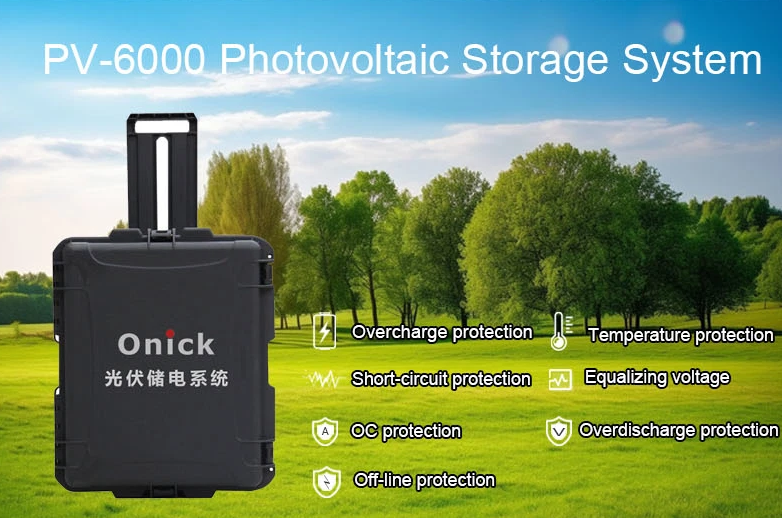When typhoons upend power lines, earthquakes tear apart power grids, or rescue operations encounter power shortages in remote mountainous areas, the importance of outdoor emergency power backup becomes even greater. Photovoltaic energy storage systems, especially specialized equipment like the Onick VP-6000, are becoming an indispensable power source for outdoor emergency situations with their core strength of "self-contained energy plants."

I. Power Pain Points in Outdoor Emergency Response and the Solution of Photovoltaic Energy Storage
Power demand in outdoor emergency scenarios is often characterized by suddenness, uncertainty, and continuity. Traditional generators rely on fuel and often fail due to fuel depletion in remote mountainous areas or disaster sites. Furthermore, noise and exhaust emissions disrupt the rescue environment. Ordinary power banks have limited capacity and can only provide short-term power for small electronic devices. Photovoltaic energy storage systems, on the other hand, rely on solar energy for energy and can generate power continuously as long as there is sunlight, effectively solving the problem of energy endurance anxiety. The Onick VP-6000's 6000Wh high-capacity battery can power a 2000W emergency lighting unit for three hours, providing long-lasting illumination at the rescue site. It can also simultaneously charge four laptops, eight smartphones, and two walkie-talkies, ensuring smooth communication. During a mountain search and rescue operation, the system powered satellite phones, life detectors, and other equipment for seven consecutive days. Its solar panels only require four hours of active sunlight per day to replenish 80% of the daily power consumption, completely eliminating dependence on external energy sources.
II. Core Advantages of the Onick VP-6000 for Outdoor Emergency Response
(I) Durability in Extreme Environments
Outdoor emergency response scenarios are often accompanied by severe weather conditions such as heavy rain, dust storms, and low temperatures. The equipment's weather resistance directly determines its usability. The VP-6000's PP casing is IP65 waterproof and can withstand brief downpours. Its wide operating temperature range, from -20°C to 50°C, allows it to withstand both the freezing cold of the snowy plateaus and the scorching heat of the Gobi Desert. During an earthquake rescue operation, the casing was only slightly deformed after being struck by falling rocks, while the internal battery and circuitry maintained stable output, providing critical power for hydraulic demolition tools.
(II) Rapid Deployment "Plug-and-Play" Design
Emergency rescue efforts are time-sensitive, and speed in equipment deployment is crucial. The VP-6000's foldable solar panel unfolds in just two minutes. Its magnetic mounting system allows it to be quickly attached to a vehicle roof or flat ground. Once unpacked, the VP-6000 connects the panel to the load, and power is available within 30 seconds. Compared to traditional diesel generators, which require complex fueling and wiring procedures, this design improves deployment efficiency by over 80%, saving valuable time during rescue operations. (III) Smart Power Distribution: "Precise Supply"

In emergency scenarios, power priorities for different equipment vary significantly—life-support equipment requires priority, while less critical equipment can be deferred. The VP-6000's control system automatically identifies load type and, when the battery level drops below 20%, automatically cuts off non-essential power, prioritizing the operation of critical equipment such as defibrillators and ventilators. During an outdoor medical rescue, the system detected low battery levels and automatically shut down backup lighting, directing the remaining power to a cardiac compressor, buying time for the injured patient to recover.
III. Photovoltaic Energy Storage Systems Reshape the Logic of Outdoor Emergency Power
Traditional outdoor emergency power backup relies on passive recharge, while photovoltaic energy storage systems enable active energy generation. This innovative model is rewriting the rules of emergency power supply. Devices like the Onick VP-6000 are not just power storage devices; they also function as small clean energy stations. During the transitional period of post-disaster reconstruction, they can provide basic electricity to temporary shelters, allowing small refrigerators to store medicines and electric cookers to heat food, thus upgrading rescue efforts from "survival support" to "life support."
As technology evolves, future photovoltaic power storage emergency systems may achieve even smarter networking capabilities—connecting multiple devices to form microgrids, sharing power information in real time through the Internet of Things, and dynamically allocating power resources. For now, however, the Onick VP-6000 has proven that photovoltaic power storage systems are not just an option for outdoor emergency power backup, but a necessity. They make every ray of sunlight count, bringing hope to those without electricity.


